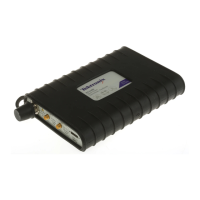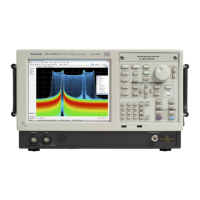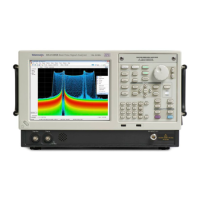Performance ver
ification
9. Calculate and record the IF feedthrough spur amplitude in dBc (IF amplitude (dBm) +30).
10. Repeat steps 7 through 9 for each center frequency listed in the table. Do not change the signal generator frequency.
11. Rec o rd results in the Test record.
Table 19: 1190 MHz IF feedthrough spurious: RSA306B center frequencies
Center frequency, MHz
(RSA306B)
IF feedthrough spur
amplitude, dBm
IF feedthrough spur
amplitude, dBc
1
Specificatio
n, dBc
(relative to –30 dBm
input)
2600 MHz < –45 dBc
3100 MHz < –60 dBc
4000 MHz < –60 dBc
4800 MHz < –60 dBc
5100 MHz < –60 dBc
5900 MHz < –60 dBc
1
IF feedth
rough spur amplitude + 30.
2440 MHz IF feedthrough.
12. Set the signal generator to 2440 MHz.
13. Set the signal generator for -30 dBm at the power meter. This is also the amplitude at the input of the RSA306B. The
generator amplitude will be close to -24 dBm.
14. Set the RSA306B to the center frequency shown in the first column of the 2440 MHz IF feedthrough table. (See Table 20
on page 46.)
15. Measure and record IF feedthrough spur amplitude.
16. Calculate and record the IF feedthrough spur amplitude in dBc (IF amplitude (dBm) +30).
17. Repeat steps 14 through 16 for each center frequency listed in the table. Do not change the signal generator frequency.
18. Record results in the Test record.
Table 20: 2440 MHz IF feedthrough spurious: RSA306B center frequencies
Cen
ter frequency, MHz
(RSA306B)
IF f
eedthrough spur
amplitude, dBm
IF f
eedthrough spur
amplitude, dBc
1
Specification, dBc
(re
lative to –30 dBm
input)
30 MHz < –60 dBc
71
0MHz
<–
60 dBc
1800 MHz < –60 dBc
4200 MHz < –60 dBc
1
IF feedthrough spur amplitude + 30.
46 RSA306B Specifications and Performance Verification
